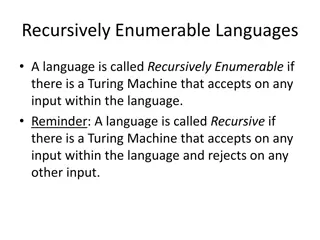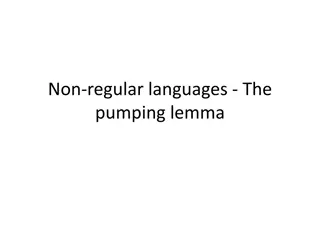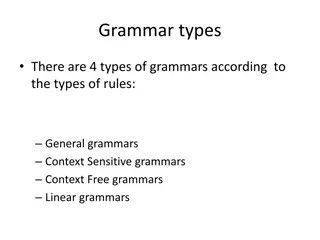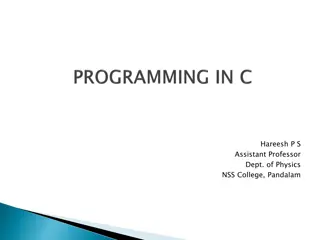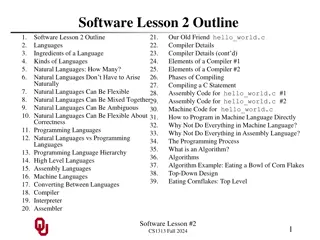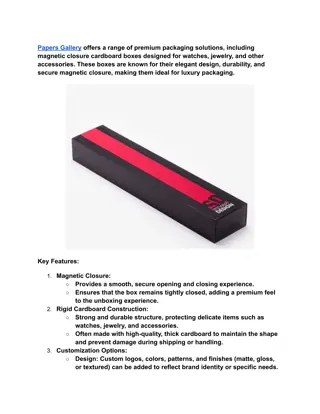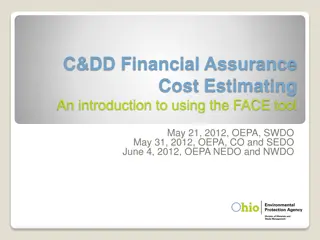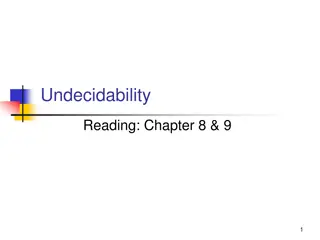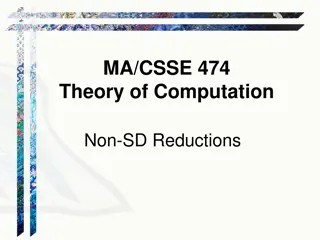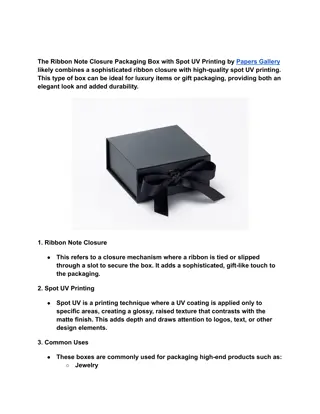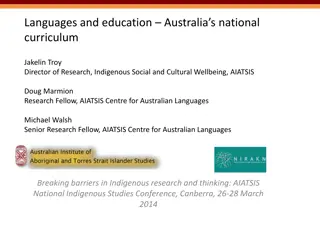Closure Properties in Context-Free Languages
Explore the closure properties of context-free languages, including union and intersection operations. Learn how to prove closure under intersection and discover the limitations of context-free languages. Delve into PDA languages and understand the challenges faced in language manipulation.
Download Presentation

Please find below an Image/Link to download the presentation.
The content on the website is provided AS IS for your information and personal use only. It may not be sold, licensed, or shared on other websites without obtaining consent from the author.If you encounter any issues during the download, it is possible that the publisher has removed the file from their server.
You are allowed to download the files provided on this website for personal or commercial use, subject to the condition that they are used lawfully. All files are the property of their respective owners.
The content on the website is provided AS IS for your information and personal use only. It may not be sold, licensed, or shared on other websites without obtaining consent from the author.
E N D
Presentation Transcript
CSE 105 Theory of Computation Alexander Tsiatas Spring 2012 Theory of Computation Lecture Slides by Alexander Tsiatas is licensed under a Creative Commons Attribution-NonCommercial-ShareAlike 3.0 Unported License. Based on a work at http://peerinstruction4cs.org. Permissions beyond the scope of this license may be available at http://peerinstruction4cs.org.
From last time CONTEXT-FREE LANGUAGES: CLOSURE PROPERTIES
Closure properties: union Last class: CFL s are closed under union. If L1 and L2 are context-free languages, then L1 U L2 is a context-free language.
Closure properties: intersection How could you prove that CFL s are closed under intersection? a) Pick two CFL s L1 and L2, and construct a CFG for L1 L2 b) Show that for any two CFL s L1 and L2, you can combine CFG s to make a CFG for L1 L2 c) Show that any CFL L can be written as L1 L2 for two CFL s L1, L2 d) Use the pumping lemma for CFL s
Closure properties: intersection How could you prove that CFL s are NOT closed under intersection? a) Show that there are CFL s L1, L2 such that L1 L2 is not context-free b) Show that for any two CFL s L1 and L2, the intersection L1 L2 is regular c) Show that there are CFL s L1, L2 such that L1 L2 is context-free, but either L1 or L2 is not d) Use the pumping lemma for CFL s
Proving that languages that are NOT context-free CONTEXT-FREE PUMPING LEMMA
Limits of Context-Free Languages What are the limitations of Context-Free languages What are the limitations of PDA? Stack size has no limit (infinite stack) .BUT, there s only one of them Stack can only be accessed at the top What does that mean intuitively? When would you need more than one stack? Context-Free Regular Not Context-Free
PDA Language is 0n12n Can we change this so it is 0n12n0n?
Classic Not-Context-Free Language anbncnfor some n 0 INTUITIVELY, the problem is that a PDA recognizing this language would try to: Push on the stack to count the a section, then Pop off the stack to match the b section, then You ve forgotten n, now you can t count the c section Aside: what could you do with a second stack? THIS IS NOT A PROOF!! Maybe there is a completely different way to approach this problem using PDA, which we just didn t think of yet But, turns out, there is no way to do this, and we can actually prove that
Proving {ajbkcl| 0 j k l} is not Context-Free s = apbpcp i = ??? Can t solve it with just one i! For the case analysis in this proof, we need to use i=0 for some cases, and i=2 for other cases Is that legal??? Yes. The Pumping Lemma Game shows us why
The REGULAR LANGUAGES Pumping Lemma Game Your Script I m giving you a language L that I m assuming is regular. Pumping Lemma s Script Thanks. For the language L that you ve given me, I pick this nice pumping length I call p. Great string, thanks. I ve cut s up into parts xyz for you. I won t tell you what they are exactly, but I will say this: |y| > 0 and |xy| p. Also, you can remove y, or copy it as many times as you like (as in xyiz), and the new string will still be in L, I guarantee! Excellent. I m giving you this string s that I made using your p. It is in L and |s| p. I think you ll really like it. Hm. I followed your directions for xyz, but when I [copy y N times or delete y], the new string is NOT is L! What happened? Well, then L wasn t a regular language. Thanks for playing.
The CONTEXT-FREE LANGUAGES Pumping Lemma Game Your Script I m giving you a language L that I m assuming is context-free. Pumping Lemma s Script Thanks. For the language L that you ve given me, I pick this nice pumping length I call p. Great string, thanks. I ve cut s up into parts uvxyz for you. I won t tell you what they are exactly, but I will say this: |vy| > 0 and |vxy| p. Also, you can remove v and y, or copy them as many times as you like (as in uvixyiz), and the new string will still be in L, I guarantee! Excellent. I m giving you this string s that I made using your p. It is in L and |s| p. I think you ll really like it. Hm. I followed your directions for uvxyz, but when I [copy vy N times or delete vy], the new string is NOT is L! What happened? Well, then L wasn t a context-free language. Thanks for playing.
Case Analysis Let s = apbpcp, and suppose s is split into uvxyz with |vy| > 0 and |vxy| p. Which of the following can describe vy? a) vy contains no symbols b) vy contains 1 type of symbol c) vy contains 2 types of symbols d) vy contains all 3 types of symbols e) None or more than 1 of the above e. b and c
Pumping Lemma Practice Thm. L = {anbncn | n 0} is not context-free. Proof (by contradiction): Assume (towards contradiction) that L is context-free. Then the pumping lemma applies to L. Let p be the pumping length. Choose s to be the string apbpcp. The pumping lemma guarantees s can be divided into parts uvxyz s.t. for any i 0, uvixyiz is in L, and that |vy|> 0 and |vxy| p. But if we let i = ____, we get the string XXXX, which is not in L, a contradiction. Therefore the assumption is false, and L is not context-free. Q.E.D. Which of the following choices for i will work? a) i = 0 b) i = 1 c) i = 2 d) None or more than 1 of the above d. a and c
So, are CFLs closed under intersection? We just proved that {anbncn | n 0} is not a CFL. Are CFL s closed under intersection? a) Yes b) No
Are CFLs closed under complement? We just proved CFL s are not closed under intersection, and we know they are closed under union. For two CFL s L1, L2, it is possible to write their intersection as: L1 L2 = (L1 U L2 ) Are CFL s closed under complement? a) Yes b) No
Pumping Lemma Practice Thm. L = {ajbkcl | 0 j k l} is not context-free. Proof (by contradiction): Assume (towards contradiction) that L is context-free. Then the pumping lemma applies to L. Let p be the pumping length. Choose s to be the string ______. The pumping lemma guarantees s can be divided into parts uvxyz s.t. for any i 0, uvixyiz is in L, and that |vy|> 0 and |vxy| p. But if we let i = ____, we get the string XXXX, which is not in L, a contradiction. Therefore the assumption is false, and L is not context-free. Q.E.D. Will the same string (s = apbpcp) work for this proof? a) b) Yes No
Pumping Lemma Practice Thm. L = {ajbkcl | 0 j k l} is not context-free. Proof (by contradiction): Assume (towards contradiction) that L is context-free. Then the pumping lemma applies to L. Let p be the pumping length. Choose s to be the string apbpcp. The pumping lemma guarantees s can be divided into parts uvxyz s.t. for any i 0, uvixyiz is in L, and that |vy|> 0 and |vxy| p. But if we let i = ____, we get the string XXXX, which is not in L, a contradiction. Therefore the assumption is false, and L is not context-free. Q.E.D. Which value of i will work for this proof? a) b) i = 0 i = 1 c) i = 2 d) No value of i works in all cases d
Pumping Lemma Practice Thm. L = {ajbkcl | 0 j k l} is not context-free. Proof (by contradiction): Assume (towards contradiction) that L is context-free. Then the pumping lemma applies to L. Let p be the pumping length. Choose s to be the string apbpcp. The pumping lemma guarantees s can be divided into parts uvxyz s.t. for any i 0, uvixyiz is in L, and that |vy|> 0 and |vxy| p. But if we let i = ____, we get the string XXXX, which is not in L, a contradiction. Therefore the assumption is false, and L is not context-free. Q.E.D. Suppose vy consists of only a s or only a s and b s. Which value of i will work for this proof? a) b) i = 0 i = 1 c) i = 2 d) a or c c. a doesn t work b/c you can take the same amt of a s and b s out
Pumping Lemma Practice Thm. L = {ajbkcl | 0 j k l} is not context-free. Proof (by contradiction): Assume (towards contradiction) that L is context-free. Then the pumping lemma applies to L. Let p be the pumping length. Choose s to be the string apbpcp. The pumping lemma guarantees s can be divided into parts uvxyz s.t. for any i 0, uvixyiz is in L, and that |vy|> 0 and |vxy| p. But if we let i = ____, we get the string XXXX, which is not in L, a contradiction. Therefore the assumption is false, and L is not context-free. Q.E.D. Suppose vy consists of only c s or only b s and c s. Which value of i will work for this proof? a) b) i = 0 i = 1 c) i = 2 d) a or c a
Pumping Lemma Practice Thm. L = {ajbkcl | 0 j k l} is not context-free. Proof (by contradiction): Assume (towards contradiction) that L is context-free. Then the pumping lemma applies to L. Let p be the pumping length. Choose s to be the string apbpcp. The pumping lemma guarantees s can be divided into parts uvxyz s.t. for any i 0, uvixyiz is in L, and that |vy|> 0 and |vxy| p. But if we let i = ____, we get the string XXXX, which is not in L, a contradiction. Therefore the assumption is false, and L is not context-free. Q.E.D. Suppose vy consists of only b s. Which value of i will work for this proof? a) b) i = 0 i = 1 c) i = 2 d) a or c d



